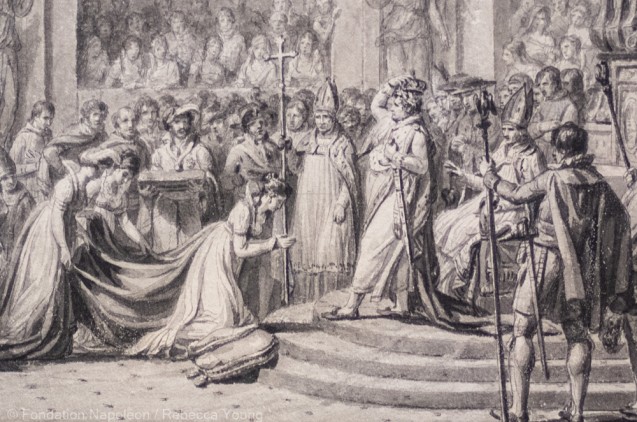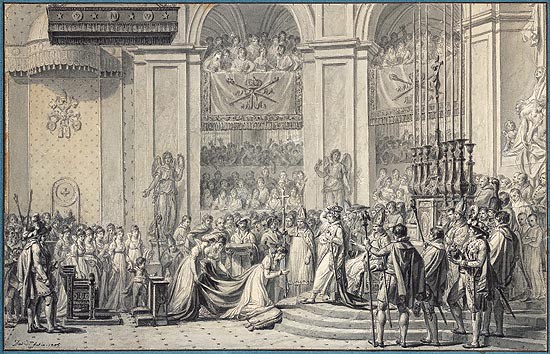Napoleon commissioned Jacques-Louis David to paint the Sacre de Napoléon (Louvre Museum) in October 1804, and the work was supposed to illustrate the forthcoming ceremony at Notre-Dame (2 December). Three other paintings were also planned but only one of them, The Distribution of the Aigles, was to be executed (Versailles).
David, the painter of the Death of Marat who was thrown into prison after the fall of Robespierre, had returned to painting antique subjects, such as Les Sabines, when he discovered in Bonaparte the modern hero that French painting seemed to be yearning for. After an unfinished portrait (1797-1798, Louvre) and a version of Napoleon on horseback crossing the Saint-Bernard pass (1800, Malmaison), the “Sacre” opened new perspectives for the artist. He found his subject contained “more inspiration for painting” than he had expected. He was furthermore spurred on by the success of his pupil Gros, whose Napoleon visiting the plague victims of Jaffa, a highly-coloured contemporary subject, had been a triumph at the Salon of 1804.
David called the Sacre a «peinture-portrait» (a painting-cum-portrait), and it was executed with the assistance of Georges Rouget on a vast canvas measuring 6.21 m. by 9.79, larger (he wrongly thought) than that for Veronese’s Wedding at Cana. He began it on 21 December, in an atelier in the church of the former Collège de Cluny, in the Place de la Sorbonne, and finished it in November 1807, retouching it at the beginning of 1808. It was exhibited on its own at the Louvre and later shown at the Salon of 1808 before appearing again in 1810 for the “Concours décennal” (ten-year competition). The emperor’s remarriage in that year however made it impossible for the work to installed in a palace. The most famous painting of the empire was therefore seen by the public for barely six months.
This important sketch, signed and dated ‘1805’, is the most complete of the three known preparatory sketches showing the entire composition, all of which show the Emperor crowning himself. The painter preferred this bold gesture which in fact matched what actually happened, but it appeared to give Napoleon an arrogant and provocative image: Gérard, established portrait painter at the court, suggested to David that he modify the figure to show the emperor crowning his consort, which is what David in the end did. Napoleon, who saw in this ‘a little intrigue of Josephine’s with David’, praised the painter for having shown him as a ‘French knight’. From being a great Emperor in the roman model he had become a Bayard…

Madame Mère (famously absent from the ceremony of which she disapproved) is not shown in this picture. Napoleon demanded that she be painted in. The Pope, mitre on his head, blesses the act: David abandoned this gesture, but Napoleon had him paint it back in in January 1808. It is this stage of composition which is shown in a sketch painted on board, recently detected under a Portrait of Pius VII and of Cardinal Caprara at the Museum in Philadelphia.
Sylvain Laveissière (tr. P.H.)
Curator of the Paintings department at the Louvre
April 2013
This painting was shown as part of the exhibition Napoléon et l’Europe at the Musée de l’Armée in Paris, from 27 March 2013 to 14 July 2013.
It will be presented at the exhibition Jacques Louis David: Radical Draftsman at the MET, New York, from 17 February- 15 May 2022.
This painting is one of the masterpieces of the Fondation Napoléon’s collection, which you can learn more about here.


